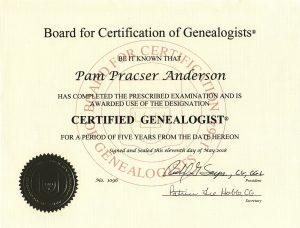
Vacationing with Your Ancestors – With the Help of a Certified Tourism Ambassador (CTA)
It’s that time of year when we all begin planning and looking forward to summer vacations. And if you’re like me, you try to schedule at least one trip around researching some of your ancestors in a really great place—and everyone in Franklin County, Pennsylvania hopes your ancestors lived here—and that you’ll be visiting us soon!
To help prepare for your trip, check out our Certified Tourism Ambassador (CTA) program through the Franklin County Visitors Bureau (FCVB). This year, the FCVB invested in this nationwide program whose objective is “to increase regional tourism by inspiring front-line employees and volunteers to turn every visitor encounter into a positive experience.” So how does a CTA fit into a genealogy vacation?

My hope is that by becoming a CTA, I can make every researchers’ visit to Franklin County the most fulfilling it can be. I do this by studying all aspects of Franklin County, to be the go-to source for finding Pennsylvania ancestors. I’ve learned through experience that my most successful trips were those where I contacted area experts who helped guide my research. Rather than using the hit-and-miss method when I wasn’t familiar with county towns and townships, these knowledgeable people pointed me to the most important repositories and sights, such as:
- Courthouses & Archives
- Historical Societies & Libraries
- Ancestral Homes & Farms
- Schools
- Businesses
- Churches
- Funeral Homes & Cemeteries
Besides giving directions, locals also know what records each repository may hold that will helpful when researching your family history. We also know the best and most convenient lodging, restaurants, and other non-genealogy things to do (for any family members who might not be into the research thing).
So when planning your “family” vacation, don’t forget to contact someone who will make sure you spend your time as efficiently and productively as possible. In Franklin County, it’s definitely a CTA—and it could be me!

Put Aside the Dead People . . . Just for a While
Besides ancestor hunting, one of the best things about researching our genealogy is re-uniting with and meeting new cousins. This week I’m lucky enough to do this again at a “Mini Marquet Reunion” in California. I’ll be reconnecting with a cousin who I haven’t seen since the 1970s, meeting another cousin’s daughter, and introducing a fifth cousin that I met through the internet, to all of these people.
My mother, Miriam Marquet, and her two older brothers, Win and Art, were raised in Berwyn, Illinois in the 1930s and 40s. By the 1960s, the Marquet brothers and their families were living in California.
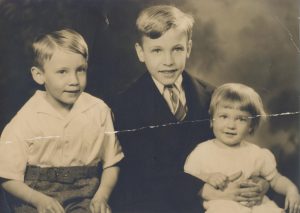
Our family traveled west a couple times to visit my uncles in the 1970s—five kids in a station wagon without air conditioning, and once with a collie! We couldn’t wait for the Holiday Inn swimming pool!!
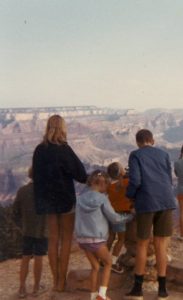
But then I lost touch with my Marquet cousins—until 2012, when I contacted my cousin Matt, Art’s son, who was still in California. I knew his mother was interested in genealogy, so I asked if he had any information on the Marquet family. Because I made the effort to reach out, he sent me tons of old photographs and documents. It was then that I was proclaimed the family historian. That same year I was contacted, through Ancestry.com, by Jane, a fifth cousin who also lives in California. It turns out that she and I share a five times great grandfather, James McMaster, who we were both researching. Two maternal cousins living in the same state meant that a trip out west was in order. My husband,Tom, and I traveled there in 2013, where I met Jane in person and reconnected with Matt and his wife, Sherry.

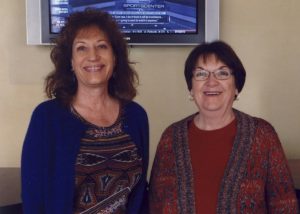
But what about my Uncle Win’s family? About a year later, I saw that my cousin Amy had developed a tree on Ancestry.com, so I messaged her. In the fall of 2016, she came to Chambersburg, Pennsylvania “on her way” to a cruise out of New York City. She rented a car in NYC, and drove 4 hours south—definitely not on her way—to reconnect with my two New Jersey sisters, Chris and Kim, and me. Since she made that crazy trip, I promised to go back to California, and that’s where I’m headed this week.

So on Saturday, January 27, Amy is hosting our first Mini Marquet Reunion at her house. Matt and Sherry will be there, and even Jane has agreed to drive down and meet more cousins. Amy’s sister, Mallory, is also coming, as are (I hope) the cousins’ children—first cousins once removed. I’m so psyched to meet more living people!!!
And maybe after talking genealogy a little, we’ll put aside the dead people, just for a while, and be thankful for the opportunity to meet new cousins and reconnect with the old—and yes, we are getting old! But hopefully some of those “once removeds” will carry on in the ancestor hunt where we leave off.
Finally, this year, I encourage everyone to take a break from your computers and archives, and connect or reconnect with your living family. You just may enjoy them more!
You Always Remember Your First Time. . . .
Your First Franklin County Genealogy Workshop, Of Course!
Yes, it’s over *sad face* but it was so much fun! A great group attended our first “Finding Family in Franklin County” genealogy workshop. Because of their honest feedback, I am calling this our Pilot Program. I especially enjoyed catching up with everyone at breakfast and dinner. My first question was always—hesitantly—“Did you find any new records?” And the answer from everyone was, “YES!” Someone even found a real live cousin!
The attendees from Virginia, Philadelphia and Pittsburgh checked into the Mercersburg Inn at noon on Wednesday. That afternoon, we presented three 45-minute sessions:
- The Genealogical History of Franklin County – Janet Pollard, Franklin County Visitors Bureau
- Original Records, In and Around Franklin County – Justin McHenry, Franklin County Archives
- A Guide to Franklin County Repositories – Pam Anderson, Anderson CoGen
Wednesday night, we met for dinner at the James Buchanan Pub and Restaurant for great conversation and discussion of plans for Thursday—where people going and what they were looking for.
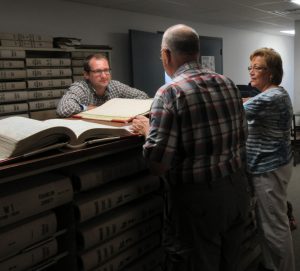
On Thursday morning we met for breakfast to give everyone an encouraging send-off. Individuals went to the Conococheague Institute in Welsh Run, Fendrick Library in Mercersburg—actually 2 people went there Wednesday before and after dinner—the Franklin County Historical Society and of course, the much heralded Franklin County Archives. Coincidentally, everyone was researching in the south-western part of the county, so they could discuss where they were going and what resources they were looking for. As I checked in at the various repositories, it was evident that everyone was doing fine, and appreciated the time to research on their own. We met again for dinner and to share what everyone found. Justin McHenry at the Archives was clearly the star of the day, finding records that others were not aware existed.
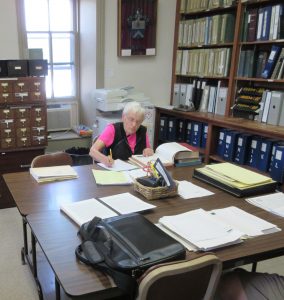
On Friday morning, at our final meal together, the group openly shared their thoughts on the workshop. This was a true debrief of what everyone liked and what could be improved for next time—and there WILL be a next time! Because of the great relationships we developed in three short days, we got excellent feedback on what to continue and what to add. Some of the suggestions were to include historic tours as an option, rotate the venue around the county, discuss more about cemeteries and church records, and include more “locals” from the genealogy community—all ideas that we will definitely look at incorporating into the next session.
But mostly there was praise for the workshop:
“This workshop would benefit beginning researchers as well as more experienced researchers because we could choose What and Where to research and go at our own pace. The discussions about the local repositories and what they offer was the jumping off point for us to explore what interested us. Pam was an excellent facilitator to point us in the most advantageous direction for our personal research goals.”
I couldn’t have worked with a better team. Thank you Janet and Justin—and my advisors!!
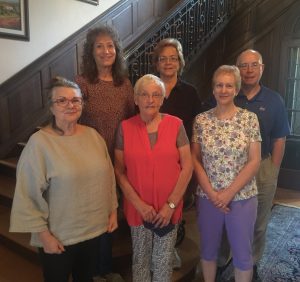
After the group picture—it’s what we genealogists do—I thought everyone would head home, but I was wrong. After checking out, everyone went on another excursion, either to a repository or sight-seeing around the county. And I went home, satisfied that we did what we set out to do—help others Find Family in Franklin County.
Finding Family in Franklin County – June 2017 Workshop and Getaway!
In less than two months, I will be collaborating with several people who share an interest and expertise in Franklin County, Pennsylvania genealogy. We are joining forces to put together the first Franklin County Genealogy Workshop (and Retreat). We’ve added “Retreat” because of the beautiful home-base for this workshop – the amazing Mercersburg Inn in Mercersburg, Pennsylvania. Jim and Lisa McCoy, owners of this magnificent bed and breakfast have given us special rates for this event and will serve up breakfast and dinner for two days!
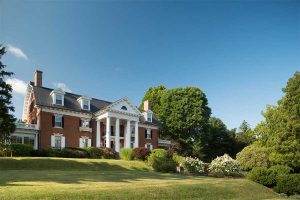
Besides meeting others researching ancestors in Franklin County, we will answer your questions such as:
- When was Franklin County formed?
- What if my ancestors were living in Franklin County before it was a County?
- Why did people move here and why did they leave?
- What original records are available and where are they?
- What are Orphans’ Court Records and why should I look for them?
- How do I find my ancestors’ cemeteries?
- What research options are available to me after I return home?
Check out the details:
The Schedule:
Wednesday afternoon, June 21:
- 1:00pm Check-in
- Interactive Presentations:
- 1:30 The Genealogical History of Franklin County – Janet Pollard, Franklin County Visitors Bureau
- 2:30 Original Records, In and Around Franklin County – Justin McHenry, Franklin County Archives
- 3:30 A Guide to Franklin County Repositories – Pam Anderson, Anderson CoGen
- 6:00pm Dinner
Thursday, June 22:
- 8:00am Breakfast
- 9:00am-4:00pm Research and lunch on your own
- 6:00pm Dinner
Friday morning, June 23:
- 8:00 Breakfast
- 10:00 Checkout (or choose to add another day)
- Continuing researching your ancestors
Schedule individualized consultations with Pam Anderson on Wednesday, Thursday and Friday.
Accommodations:
405 S. Main Street
Mercersburg, PA 17236
717-329-5231
Cost: Wednesday & Thursday – One-person Registration with Dinners – $355 per room
Add on Friday Night Stay for $110
*Additional person $110 – shared room occupancy
Contact me at (717) 597-1345 or [email protected] if you have any questions.
We hope you can join us!!
The Power of a Letter – Shared with a Genealogist
Sometimes we are lucky enough to have a friend who entrusts us with a special gift. About a year ago I was that lucky person. And about a month ago, my friend—who is the most magnificent writer—shared her story. Mitchell Kyd, AKA Yvonne Butts-Mitchell, said that I could share it here.
As genealogists, we are told to analyze documents to glean and evaluate every bit of information we can. We check for originality, who provided the information, and if the information is direct or indirect (or negative) evidence to answer a question we have about our ancestors. It sounds so impersonal, until someone like Yvonne tells the story behind the research.
Yvonne handed me her gift–a letter written in November, 1926. Following is the story she wrote about that letter, based on my genealogy research. Please check out her blog, Dead Mouse Diaries, for great reads about everyday life–the life that most of our ancestors led.
News from the Path Valley Hotel, Episode #96: The Power of a Letter
In a very ordinary way, my cousin Candy handed me an extraordinary gift last spring: a little, yellowed envelope she had found among her mother’s things. The postmark was pale and blurred but discernible: November, 1926. It had been addressed to her grandmother Florence. Why her mother had kept it all those years remains a mystery to us both but Candy knew I’d enjoy it. Although we shared a grandmother on our dads’ side, the letter had been an exchange between our maternal grandmothers, mailed to hers and written by mine.
At first blush, it was an exchange of news between two high school friends who had been separated by distance and life changes. From the start, it offered the promise of a delightful peek behind the curtain for this storyteller, but something seemed unsettling.
I knew instantly the thick, black pencil strokes on the envelope didn’t look like my grandmother’s handwriting but the name in the return address seemed unmistakable. In the style of the day, the writer had used her husband’s formal name, my pap’s, with a “Mrs.” preceding it. When I pulled out the letter, I was thrown off again, struck that the writing style seemed off somehow, not my grandmother’s fluid lines and careful grammar. I skipped ahead to the signature on the last page. Again, it was signed as “Mrs.” The writer was certainly my pap’s young wife.
The pages were filled with girl talk, the young bride wrote to ask her friend Florence about her baby and how her life was going as a young mother. She asked her friend how she liked having her hair shingled and what she wanted for Christmas, then added: “Maybe you are like me. Take anything I get.”
It was a line of news on the second page that stopped me cold. The letter told of family deaths, including the writer’s sister who had left seven young children behind. I remember running my finger over the handwriting then, looking again at the signature, going back to the postmark. My grandmother never had a sister and she married Pap in 1930. The tears welled up as I realized then what a treasure I was holding in my hand, a key to a family mystery.
When I was very young, Pap used to take me to visit a woman we called Grandma Horn. Although she was always delighted to see us both, and always treated me with the best grandma-like affection, I never understood how our lives fit together. My “real” grandma, Pap’s wife, never went with us but always sent her regards. Grandma Horn returned the sentiment.
I don’t remember when Grandma Horn died. I didn’t go to her funeral but I’m sure Pap did, probably 50-something years ago. Sometime after that, I started to catch bits and pieces of her story: my pap had been married once before and Grandma Horn had been his first mother-in-law. The letter I was holding had been written by her daughter Helen.
In very vague terms, I’ve known for decades that Pap’s first wife Helen had died and that he had lost an infant son, too. End of story. Even my mother didn’t know much more. The hush wasn’t really a cover up, I learned later; the memories were simply too painful. Time passes; memories fade. The generations before us disappear and are reduced to an occasional comment at a random family gathering. I learned nothing more about Helen or their son until my mother showed me her cemetery marker three years ago.
When the gift of a letter connected me with Helen and the woman I loved as Grandma Horn, I shared the story with close friends, among them genealogist Pam Anderson. In her hands, Helen’s letter opened doors that had been locked in my family history. Pam dug into public records and newspaper files. Her research and tenacity brought me census records, marriage applications, birth certificates and obituaries. Here’s a sampling of what her excavations uncovered, all triggered by one letter from a seventeen-year-old newlywed:
Grandma Horn’s first name was Ida; she had been a maid. Helen’s dad, Grandma Horn’s husband, was David, a laborer, who was 23 years older than Ida when they married. Both had children from former relationships. Although Ida could read and write, David made an “X” on the marriage application rather than adding a signature indicating he was illiterate. He did own property which meant he had made his way in the world, regardless.
Helen was born March 2, 1909. While her marriage to my pap was not recorded in Franklin County, her letter to Florence reveals they married on February 26, 1926, just before her 17th birthday. It’s unlikely that she knew it when she was writing to Florence in November, but she was probably two months pregnant at the time. Other records show that her infant son died when two months premature, on April 12 , 1927, two days after my pap’s birthday. Helen died one week later when she was barely 18.
The baby’s death certificate calls him “John.” I’m guessing that at the time of death, Helen was too ill and my pap too overwhelmed to have declared a name. When the obituary appeared a few days later, the baby’s name was listed as Charles David, a combination of both grandfathers. Helen’s obituary in the local newspaper attributes her death to pneumonia, like most others listed that same day and the week preceding.
March 2, 2017, would be Helen’s 108th birthday. Ironically, she shared that birthday with my great-grandmother, pap’s second mother-in-law. I realize now that day that must have been rough for him to celebrate as the rest of us gathered for her cake and ice cream each year.
Helen did not leave a written account of her short time here and until last year, she was merely a cemetery marker in my layer of family history. One little letter has made her real for me and helped me pass along a part of her story.
Happy birthday, Helen. You and the little soul who was among us barely long enough to get a name have not yet been forgotten. And to Florence, Roberta and Candy– thank you for recognizing and preserving the power of a letter.

The other cool thing: Helen and I share a birthday!



